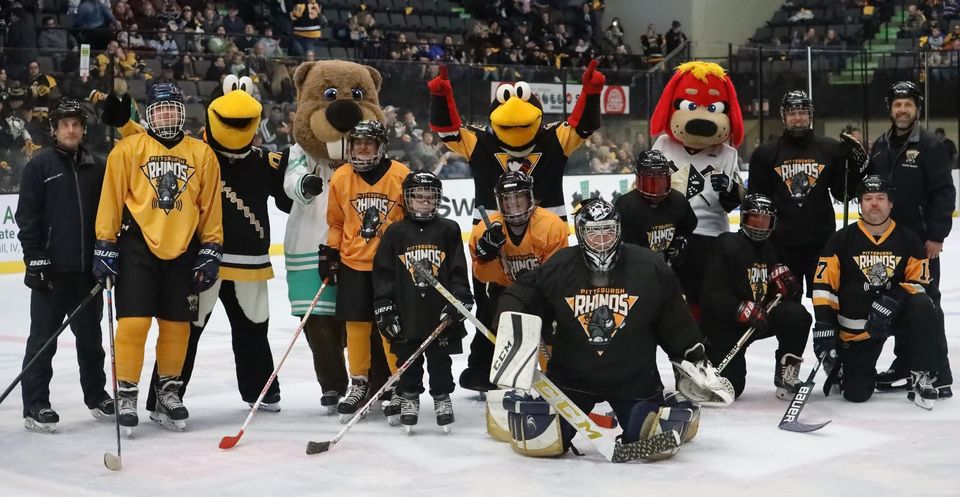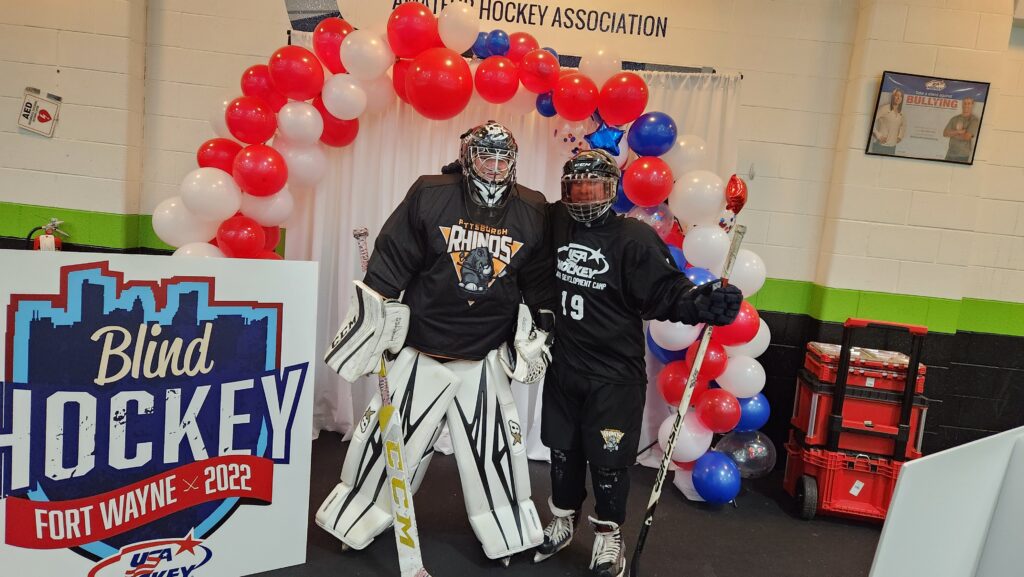Since 2016, blind and visually impaired individuals in the Pittsburgh area have experienced the joy of playing hockey.

Blind ice hockey was first introduced in Canada in the early 1970’s, but was played mainly in regionalized areas with little to no national or international attention for nearly 40 years.
It wasn’t until 2010 that the sport gained traction across Canada. Four years later, blind hockey came to the United States with the formation of a team in New York.
In 2016, a team in Pittsburgh took shape through an organization that provided a number of sports for adaptive athletes in the area. Three years later, the group underwent a management change with the objective of concentrating exclusively on hockey, and Pittsburgh Rhinos Blind Hockey was born.
Grant and Tammy Kitterman registered their son Brock in a sports camp held by the group when he was 11. Blind hockey was one of the sports he participated in, and he was one of four players selected to start a team in Pittsburgh. When the management change occurred three years later, the Kittermans took over running the club. Tammy is president, and Grant the coach. Brock, now 18, remains one of the charter members of the team now known as the Rhinos.
“He’s the only one (of the four original players) left playing hockey,” Tammy Kitterman said.
Unlike many other adaptive sports, blind hockey requires few modifications. The puck is larger and slower than a traditional hocky puck and makes noise so blind players can track its movement. Both blind and visually impaired individuals who meet one of three vision classifications authorized by the International Blind Sports Federation are eligible to play. The sport is governed by USA Hockey, which hosts two national level events each year.
The Rhinos practice weekly at Rostravor Ice Garden in Belle Vernon, a borough located along the Monongahela River about 35 miles from Pittsburgh. The Rhinos are a mix of players ranging in age from 9-25, although people of all ages are welcome.
“It’s male, female, any age. We are just out there trying to grow the sport in general. We want anybody who has a visual impairment to come and give it a try.”
Blind hockey provides more than the opportunity to compete and utilize physical skills. It gives players confidence and the ability to interact with others in a team-building situation.
“We have a younger team. Ours is the youngest team in the nation. It’s important when you’re done skating to have that time together. We always have a pool when we get together, pizza parties… We’ve taken the team to D.C. and gone sightseeing. During COVID, we made sure we had weekly or biweekly Zooms to keep in touch with everybody.”
Kitterman is well aware that hockey can be an intimidating sport, especially to someone who is blind and has never played the game. It’s a bit different for someone who played hockey before losing their vision.
“Hockey players who have grown up playing then lost their vision later in life, they’re not afraid to try it. They’re the first ones to say, ‘let’s get out there and do this’.”

The Rhinos are committed to making the sport as enjoyable as possible for anyone who wants to play. They offer three levels according to skill level. The blue level is for beginners, white is intermediate, and red is for elite athletes aspiring to make the U.S. National Team. The team also has a Learn to Skate program.
“If you are (visually impaired) and you just want to learn to skate, come and skate with us. Once we get you comfortable on skates, then we’ll add the hockey in. We’ve done that for quite a few of our players.”
Volunteers play a major role in the operation and success of the Rhinos organization. The team has three volunteer coaches, two student coaches and even high school students who come out to help. They teach players skills and put them through workouts.
“We have wonderful volunteers that come out and help. They’re regulars, not just somebody who jumps on the ice for the first time. We’ve taught them how to assist on the ice and talk to our kids and explain positioning to them and so forth.”
Kitterman first became aware of the Foreseeable Future Foundation after receiving a grant for Brock to compete as a triathlete. She contacted the foundation again, this time on the Rhinos’ behalf. The team was given a grant earlier this year.
Hockey is an expensive sport at all levels, particularly when it comes to renting ice time. The Foreseeable Future Grant is being used exclusively to manage those costs.
“We have to fundraise for the ice time. The grant the Foreseeable Future gave us went 100 percent towards ice time.”
Blind hockey is not currently a Paralympic sport, although the U.S. has a national team. Brock was selected to the team along with his teammate, goalie TJ Stewart. Kitterman hopes the sport will be fully featured in the Paralympic Winter Games soon.
“We need eight countries on board to make it a Para sport. We currently have six. The realistic (timetable) is 2030.”
